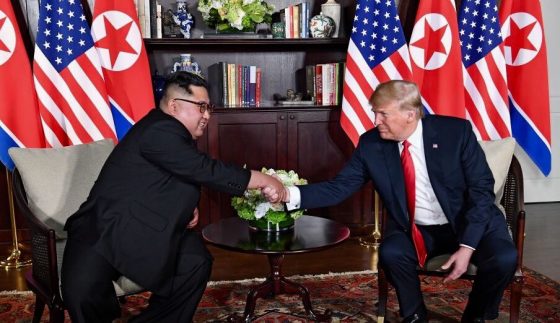BESA Center Perspectives Paper No. 894, July 15, 2018
EXECUTIVE SUMMARY: North Korean leader Kim Jong-un’s summits with US President Donald Trump and South Korean President Moon Jae-in were important milestones in solving the Korean Peninsula crisis, but they are only the first step in a long negotiation process that will take at least two years and might face several obstacles.
Analyses of the Donald Trump-Kim Jong-un summit in Singapore on June 12 tend to reflect the political slant of the analyst. To Trump supporters, the summit was very successful. To Trump detractors, it was a huge failure. Had President Obama or President Hillary Clinton signed the same agreement, the Republican party – and certainly John Bolton – would have criticized them for committing to a deal that offers Kim more than he is willing to reciprocate.
The historic summit should be viewed not as a one-time event but as the beginning of a long-term negotiation process between North Korea and the US. South Korea, China, and Japan will each have a constructive role to play. Despite the “mission accomplished” euphoria broadcast by the White House after the summit, we should expect not a quick and smooth denuclearization in North Korea but a long and bumpy road, as was apparent after US Secretary of State Mike Pompeo’s subsequent visit to Pyongyang.
The Trump-Kim summit should be analyzed in context, together with the Kim-Moon summit that took place on April 27. Both summits had pros and cons.
Direct communication channels
The Kim-Moon and Kim-Trump summits established direct communication channels that will allow the leaders of Seoul, Pyongyang, and Washington to conduct a direct dialogue. This does not, of course, guarantee that that dialogue will be without obstacles, but it allows the three leaders to communicate. This can be valuable in avoiding misunderstandings or unintended military escalation.
The change in Kim Jong-un’s public declarations
For many years, North Koreans were indoctrinated by their education system into believing that the US is an evil enemy. The publication by the official North Korean media of the declaration by Kim Jong-un, as well as articles about and photos of the Kim-Trump summit, are important steps in what will be a long journey of reconciliation.
The length of the process
The denuclearization of the DPRK, or, as Pyongyang prefers, the denuclearization of the Korean Peninsula, will take a very long time. When talking about the denuclearization of North Korea, one should take into account not just nuclear weapons but also chemical and biological weapons as well as long- and short-range missile stockpiles. Disarming the state’s unconventional weapons capabilities will involve:
- North Korea’s declaration of all sites (testing, development, manufacture, etc.)
- the uncovering of hidden sites
- the verification of all reports
- the dismantling of all manufacturing and testing sites
- the evacuation of all nonconventional weapons from North Korea.
The complete disarming of North Korea could take up to two years. The Syrian case has shown that even when a state claims to have disarmed itself, it might dupe inspectors, restart production, or use hidden nonconventional weapons. Washington will have to establish verification mechanisms that do not allow Pyongyang to cheat.
Washington’s and Pyongyang’s contradictory timeframes
Washington insists that the sanctions will be lifted only after the complete, verifiable, and irreversible dismantlement (CVID) of North Korea’s nuclear program. Kim Jong-un has said he is willing to disarm North Korea’s nuclear weapons, but he has no intention of waiting two years for the lifting of sanctions. Without economic incentives, Pyongyang will not comply with Washington’s timeframe and will try to bypass sanctions through China or other means.
Coordination
The Six-Party Talks were dysfunctional because the members didn’t agree on how and what could be achieved. In order to prevent a similar failure of negotiations between Pyongyang and Washington, the US should gain the coordinated cooperation of Seoul, Beijing, and Tokyo. Seoul supports negotiations between Pyongyang and Washington and plays a highly constructive role in promoting them and ensuring that they succeed. Without coordination, Pyongyang might be able to play the negotiations by cozying up to Beijing or Seoul.
While there are indications that encourage optimism after the two summits, there remain reasons to be skeptical about Pyongyang’s strategic decision to denuclearize. So far, North Korea has made only tactical gestures: the destruction of a nuclear test site that will not affect its nuclear capabilities, and the returning of the remains of US soldiers from the Korean War (as part of confidence-building measures). These are positive signs, but they don’t deal with the strategic capabilities of the DPRK. Once Pyongyang starts allowing Washington access to its non-conventional weapons and begins to dismantle them, there will be more reason to be optimistic. In the meantime, Washington will have to decide whether the sanctions will be lifted after the CVID or during the process.
Dr. Alon Levkowitz, a research associate at the Begin-Sadat Center for Strategic Studies, is an expert on East Asian security, the Korean Peninsula, and Asian international organizations.
BESA Center Perspectives Papers are published through the generosity of the Greg Rosshandler Family


